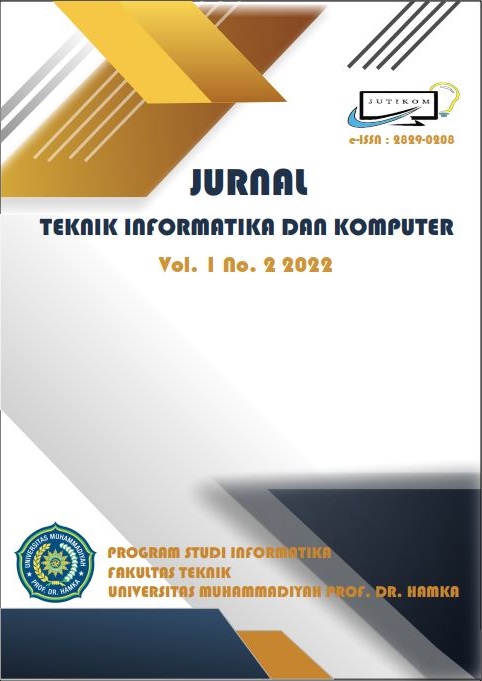Main Article Content
Abstract
The process of monitoring and measuring the performance of an employee as well as archiving performance assessment data for lecturers and educational staff at UHAMKA so far has been carried out manually in paper form which causes a lack of efficiency in its implementation and the main obstacle faced during implementation is the lack of data integration. To overcome this problem, the creation of a Key Performance Indicator (KPI)-based performance management information system for lecturers and education staff can be a solution to facilitate the process of monitoring and measuring the performance of lecturers and students at UHAMKA. The creation of this system uses the Agile method with the Scrum framework because Scrum is a product development method that focuses on business value and has high flexibility for every need that is dynamic and sustainable. The results of this study are facilitating the process of integrating and archiving data as well as helping time efficiency in the KPI data management process for lecturers and students. The results of the satisfaction and success survey on the KPI system as a whole reached 88% so that this website can facilitate the KPI data management process at UHAMKA
Keywords
Article Details
References
- Angelia, G., Sokibi, P., & Fahrudin, R. (2021). Perancangan Sistem Informasi Penilaian Kinerja Promotor Terhadap Product Knowledge Menggunakan Metode Key Performance Indicator (Studi Kasus : Pt. World Innovative Telecommunication). Jurnal Digit, 11(2), 144. https://doi.org/10.51920/jd.v11i2.200
- Bolung, M., & Tampangela, H. R. K. (2017). Analisa Penggunaan Metodologi Pengembangan Perangkat Lunak. Jurnal ELTIKOM, 1(1), 1–10. https://doi.org/10.31961/eltikom.v1i1.1
- Dharwiyanti, S., & Wahono, R. S. (2003). Pengantar Unified Modeling Language (UML). IlmuKomputer.Com, 1–13. http://www.unej.ac.id/pdf/yanti-uml.pdf
- Ghufroni An, M., & Kurniawan, A. (2022). Sistem Informasi Manajemen Berbasis Key Performance Indicator (KPI) dalam Mengukur Kinerja Guru. Jdmsi, 3(1), 2775–9660.
- Halik, A. (2014). Kajian Pengembangan Kebijakan Pelayanan Terpadu Satu Pintu (PTSP) Melalui Perspektif Indikator Kinerja Utama (IKU). Jurnal Bina Praja, 06(01), 41–50. https://doi.org/10.21787/jbp.06.2014.41-50
- Helmud, E. (2021). Optimasi Basis Data Oracle Menggunakan Complex View Studi Kasus : PT. Berkat Optimis Sejahtera (PT.BOS) Pangkalpinang. Jurnal Informanika, 7(1), 80–86.
- Hoetamy, D. M., Nugroho, A., & Harris, A. (2020). Perancangan E-Learning Pada SMK Veteran Kota Jambi Berbasis Android. Jurnal Ilmiah Mahasiswa Teknik Informatika, 2(2), 172–185. http://ejournal.stikom-db.ac.id/index.php/jimti/article/view/849
- Kadir, A. (2003). Pengenalan Sistem Informasi. Ikrar Mandiriabakti.
- Sintawati, I. D., & Puspitorini, I. (2021). Penerapan Agile Methode Berpola Scrum Dalam Ssistem Informasi Pengajuan Cuti Kerja Berbasis Web. 6(2), 186–195.
- Suwandi, E., Imansyah, F. H., & Dasril, H. (2018). Analisis Tingkat Kepuasan Menggunakan Skala Likert pada Layanan Speedy yang Bermigrasi ke Indihome. Jurnal Teknik Elektro, 11.
References
Angelia, G., Sokibi, P., & Fahrudin, R. (2021). Perancangan Sistem Informasi Penilaian Kinerja Promotor Terhadap Product Knowledge Menggunakan Metode Key Performance Indicator (Studi Kasus : Pt. World Innovative Telecommunication). Jurnal Digit, 11(2), 144. https://doi.org/10.51920/jd.v11i2.200
Bolung, M., & Tampangela, H. R. K. (2017). Analisa Penggunaan Metodologi Pengembangan Perangkat Lunak. Jurnal ELTIKOM, 1(1), 1–10. https://doi.org/10.31961/eltikom.v1i1.1
Dharwiyanti, S., & Wahono, R. S. (2003). Pengantar Unified Modeling Language (UML). IlmuKomputer.Com, 1–13. http://www.unej.ac.id/pdf/yanti-uml.pdf
Ghufroni An, M., & Kurniawan, A. (2022). Sistem Informasi Manajemen Berbasis Key Performance Indicator (KPI) dalam Mengukur Kinerja Guru. Jdmsi, 3(1), 2775–9660.
Halik, A. (2014). Kajian Pengembangan Kebijakan Pelayanan Terpadu Satu Pintu (PTSP) Melalui Perspektif Indikator Kinerja Utama (IKU). Jurnal Bina Praja, 06(01), 41–50. https://doi.org/10.21787/jbp.06.2014.41-50
Helmud, E. (2021). Optimasi Basis Data Oracle Menggunakan Complex View Studi Kasus : PT. Berkat Optimis Sejahtera (PT.BOS) Pangkalpinang. Jurnal Informanika, 7(1), 80–86.
Hoetamy, D. M., Nugroho, A., & Harris, A. (2020). Perancangan E-Learning Pada SMK Veteran Kota Jambi Berbasis Android. Jurnal Ilmiah Mahasiswa Teknik Informatika, 2(2), 172–185. http://ejournal.stikom-db.ac.id/index.php/jimti/article/view/849
Kadir, A. (2003). Pengenalan Sistem Informasi. Ikrar Mandiriabakti.
Sintawati, I. D., & Puspitorini, I. (2021). Penerapan Agile Methode Berpola Scrum Dalam Ssistem Informasi Pengajuan Cuti Kerja Berbasis Web. 6(2), 186–195.
Suwandi, E., Imansyah, F. H., & Dasril, H. (2018). Analisis Tingkat Kepuasan Menggunakan Skala Likert pada Layanan Speedy yang Bermigrasi ke Indihome. Jurnal Teknik Elektro, 11.

